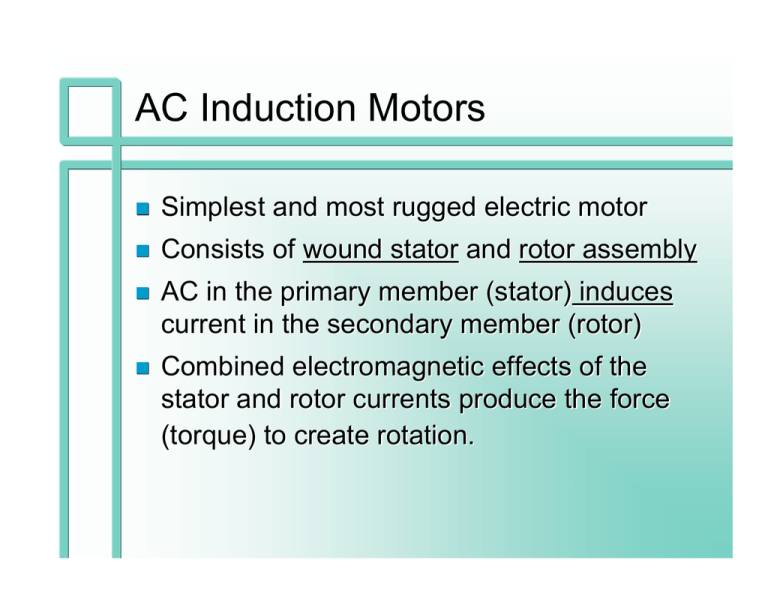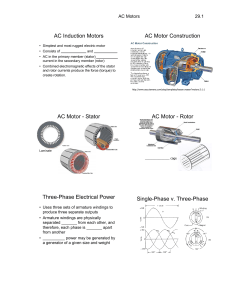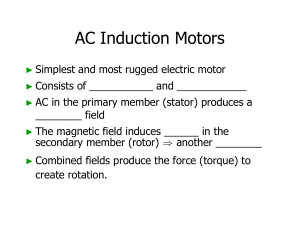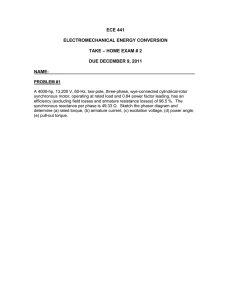Split-Phase AC Motor
advertisement

AC Induction Motors Simplest and most rugged electric motor Consists of wound stator and rotor assembly AC in the primary member (stator) induces current in the secondary member (rotor) Combined electromagnetic effects of the stator and rotor currents produce the force (torque) to create rotation. AC Induction Motors Rotors typically consist of a laminated, cylindrical iron core with slots for receiving the conductors. Common type of rotor has castaluminum conductors and shortcircuiting end rings. This "squirrel cage" rotates when the moving magnetic field induces a current in the shorted conductors. AC Motor Speed The magnetic field rotates at the synchronous speed of the motor Determined by the number of poles in the stator and the frequency of the AC 120 f power ns = p ns = synchronous speed (in RPM), f = frequency (in Hz), and p = the number of poles AC Motor Speed Synchronous speed is the absolute upper limit of motor speed. When running, the rotor always rotates slower than the magnetic field (or no torque!) The speed difference, or slip, is normally referred to as a % of synchronous speed: ns − na s = 100 ns s = slip (in %), ns = synchronous speed na = actual speed AC Motor - Speed vs. Torque % Synchronous Speed 100 75 Service factor load / torque Dashed line applicable to initial acceleration only 50 25 Minimum acceleration torque Locked rotor/starting torque 0 100 % Rated Torque Single-phase AC Motors Single phase AC motors require a "trick" to generate a 2nd "phase" to develop starting torque Three common methods: – split-phase (auxiliary winding is rotated 90°) – capacitor – shaded-pole Split-Phase AC Motor Motor starts with both main and auxiliary winding A centrifugal switch opens and removes the aux switch opens winding 100 300 75 % Rated Torque % Synchronous Speed switch opens 50 25 0 0 100 200 % Rated Torque 300 200 100 0 0 25 50 75 % Synchronous Speed 100 Split-Phase AC Motor Disadvantages Advantages Operate at ~ constant Repeated start/stop speed, 4 pole, 60 Hz: cycles heat the windings (high start – 1780 RPM (no load) resistance) – 1700/1725 RPM at full load Less useful for large inertial loads Reversible at low speed Requires large wiring to handle starting Rapid acceleration currents Relatively low cost Single-Phase Capacitor Motors Permanent split capacitor (PSC) Capacitor-start (later switched out) Start-capacitor, run-capacitor (switched) Auxiliary winding Capacitor AC Main winding Rotor 100 300 % Rated Torque % Synchronous Speed Permanent Split Capacitor (PSC) 75 50 25 0 200 100 0 0 100 200 % Rated Torque 300 0 25 50 75 % Synchronous Speed 100 Permanent Split Capacitor (PSC) Advantages Quieter, smoother than split phase Reduced starting current Disadvantages More expensive for same HP Lower performance when starting – Longer life Need to always use – Higher reliability manufacturer's Capable of frequent desired capacitor start/stop cycles value 100 300 % Rated Torque % Synchronous Speed Shaded Pole AC Motor 75 50 25 0 200 100 0 0 100 200 % Rated Torque 300 0 25 50 75 % Synchronous Speed 100 Shaded Pole AC Motor Advantages Simple in design and construction Suitable for low cost, high volume app's Relatively quiet and free from vibration "Fail safe" design starts in only 1 direction Disadvantages Low starting and running torque Low efficiency Available in subfractional to ~ 1/4 hp sizes NEMA - National Electrical Manufacturers Association NEMA is responsible for several electric motor industry "standards" Motor ratings (1/4 hp, 1/2 hp, 1 hp, etc.) Frame size – diameter, length, shaft size, etc. Service factors Housing/protection types and ratings Service Factors A multiplier applied to the rated horsepower Indicate how much the motor can be overloaded without overheating Generally used for – handling a known, occasional overload – provide a factor of safety where environment or service condition is not well known Motor Enclosures DP - dripproof DPFG - dripproof, fully guarded SP - splashproof FV - forced ventilation (separate/attached fan) TENV - totally enclosed, non-ventilated TEFC - totally enclosed, fan cooled TEUC - totally enclosed, unit cooled (heat-X) AC Motor Efficiency Efficiency, η = Power Output / Power Input Small universal motors have η ~ 30% Large 3-phase motors have η ~ 95% Depends on actual motor load vs. rated load – efficiency best near rated load – efficiency drops rapidly for both under- and over-load conditions


